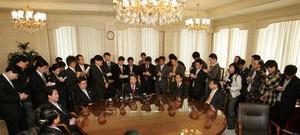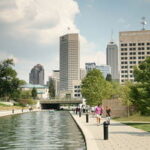The Republic of Korea encompasses 99,000 square kilometers of mostly hilly and mountainous land-with some coastal plains in the west and south. It can be compared to roughly the size of Indiana. Bodies of water surrounding it include the Sea of Japan and Yellow Sea. It has 2,413 kilometers of coastline and 100% of its population lives within 100 km of the coast. The official language of the Republic is Korean although English is taught in junior high and high school. Except for about 20,000 Chinese, the ethnic group in the Republic is homogeneous. The Republic of Korea has a republic government which combines continental European civil law systems, Chinese classical thought and Anglo-American law and its head of state is President Roh Moo-hyun (elected in February 2003) with the head of government as Prime Minister Lee Hae-chan (appointed in May 2004).
When Japan won the Russo-Japanese War in 1905, its gift was occupation of Korea (a formerly independent kingdom under Chinese suzerainty for most of its history). The Republic of Korea gained independence from Japanese occupation in August 1945, so it is a relatively new republic. Although the peninsula was no longer under occupation, it had two different governments fighting for control-the republic in the south and a Communist-style government in the north. During the Korean War, the UN and the US came to Korea to defend the South from attacks from the North supported by the Chinese. In 1953, an armistice was signed to split Korea along a demilitarized zone at the 38th parallel. Proving that democracy worked, South Korean (Republic of Korea) voters elected Roh Tae-woo as president in 1987 and thus ended 26 years of dictatorships. The North and South Korean leaders, Kim Jong II and President Kim Tae-chung, made history in June 2000 for holding the first summit between the two Koreas.
The Republic of Korea has had a booming economy since the 1960s including integration into the modern world of high technology. The republic joined the trillion dollar club of world economics in 2004 and its GDP per capita is equal to those lesser economies in the European Union. Its main exports are semiconductors, wireless telecommunications equipment, motor vehicles, computers, steel, ships, and petrochemicals and it is partners with China, US, Japan, and Hong Kong. Its main imports are machinery, electronics and electronic equipment, oil, steel, transport equipment, organic chemicals, and plastics and it is partners with Japan, US, China, and Saudi Arabia. In 2004, the republic had an external debt of $160 billion. It received economic aid from ODA for $334 million in 2003.
The Republic of Korea has a military similar to the US in that they have an Army, Navy, Air Force, Marine Corps, and National Maritime Police (Coast Guard). The amount of citizens fit for military service (males age 20-49) is 9,932,026. The military spends $16.18 billion a year (in 2004), and this is 2.8% of the GDP.
The closest military threat is obviously North Korea. There are currently periodic maritime disputes between the two Koreas over the Northern Limit Line (Military Demarcation Line within the 4-km wide Demilitarized Zone that separates North from South Korea). South Korea and Japan claim Liancourt Rocks (Tok-do/Take-shima)-occupied by the republic since 1954. However, there have been actions taken to restore diplomacy between the Koreas including the recent summit of the leaders of both governments.
Diversity among ethnic groups in the republic may cause tension as the majority of the population is Korean, and the minority is migrant workers from China, the Philippines and Malaysia and about 37,000 US military personnel. Remembering the Korean War and relatives who lost their lives may strike fury in the hearts of America military in the republic. The humiliation of having to work like an animal for a younger and smaller nation than their own may cause resentment in migrant workers. Perhaps there could be a National Intercultural Day in the republic incorporating a parade in the capital city with floats and exhibits from the countries in which migrant workers come from and something relative to the US military. Celebrating one’s home country/nation could make a world of a difference if you were in the minority and not necessarily in the country under your own free will.
The Republic of Korea has the same exports and imports as North Korea and they could both advance economically if they cooperated. They could hold a monopoly on their goods so that they would receive a better price. They could also buy products together to get a better price. Both Koreas also have the same environmental problems: air pollution in large cities; acid rain; water pollution from the discharge of sewage and industrial effluents; and drift net fishing. Their leaders could work together at future summits to work on these problems and create a plan of action for the occasional typhoons to prevent further economic damage.
There is much to be done in the way of cooperation and brotherhood with the Republic of Korea and its northern neighbor. In light of meetings between leaders from both, it seems as though both nations have realized this and want to change their situations. It is possible that the Republic of Korea can help North Korea economically and North Korea can help the republic in achieving ethnic togetherness.
The Republic of Korea has economic, social, and political problems that could be fixed through diplomacy. Economically the country is in a stop-and-go growth cycle which will be further explained with help from the International Monetary Fund. Socially the nation suffers from trafficking of its women to Japan and the U.S. for sexual exploitation. North Korea’s missile development, if unchecked, presents a political problem for the republic. Food and water shortages and quality of health care are also problems the republic of Korea face. There is also the problem of reunification of the North and South Koreas-or is it a problem?
After a long economic boom, the Republic of Korea economy suddenly stopped growing in the first half of the 2003 year, started back up in the second half and then slowed down again in the first half of 2004. There may be some correlation between this stop and go economy and the $160 billion of debt the republic had in 2004. It has already received economic aid in the amount of at least $350 million, but diplomats from the U.S. and other economically advanced countries could provide more aid to boost the republic’s economy. A quality of a good diplomat is predicting trends of issues and a representative from the U.S. could offer advice to economic advisors from the Republic of Korea about the highs and lows of the U.S. stock trade and history of our economic depressions and recessions.
Sexual exploitation of its women is a social problem of the Republic of Korea. Women from Russia, the People’s Republic of China, the Philippines, and Thailand are also trafficked to South Korea for commercial sexual exploitation. Korean women are sent to Japan and the United States as modern-day slaves in the field of prostitution. In 2004, the republic’s government passed anti-trafficking and anti-prostitution laws and social, legal and medical support for victims. Education and vocational training is needed for the women who have been trafficked and exploited. Diplomats from the U.S. and Japan could set about making stricter anti-prostitution and anti-trafficking laws in his respective countries. A successful diplomat would know who the important players are in this task (representatives of the House and Congressmen/women) and set about passing these laws.
Along with disputes over the 38th parallel, the Republic of Korea has to worry about the unchecked missile development status of its northern neighbor. Many nations around the world are believed to have missiles and nuclear weapons but it is difficult to hold diplomacy summits with one if your country does not have such weapons. North Korea can “recognize [its] limitation” and be a diplomat to its southern brother by revealing its status on such missile development. Fear and anger run rampant when ignorance is present.
A problem that faces many children in the republic is food shortages and lack of quality in health care. UNICEF is currently working on problems such as: treating malnourished children; preventing micro-nutrient deficiencies among children and pregnant (or lactating) women; immunizing children and pregnant women; supporting water supply and purification; and promoting early childhood development at the household level. Diplomats from more economically advanced countries could raise funds to give to UNICEF or continue to send ministries to help alleviate the problems of the Republic of Korea’s youngest and smallest.
Korea has been divided since 1953 along the 38th parallel. Many diplomats see this as a problem and are constantly calling for reunification of North and South. It may be, however, an equilibrium that is working as well as it can. Two governments exist on either side of the 38th parallel and to force them together might be disastrous. Diplomacy between the two Koreas is a more likely solution than the placing of communists and democrats together.
Economic, social and political problems hamper the development of the Republic of Korea, but one is hopeful that diplomats from the U.S., Japan, and the United Kingdom can help alleviate some, if not all of these. The U.N. is key to providing guidance to the republic and in helping diplomats from other countries learn more about how to help their South Asian neighbor.
United Nations General Assembly
Topic: Reunification of North Korea and the Republic of Korea
Sponsor(s): Republic of Korea
Disturbed by images in the media of demonizing the Democratic Party of the Republic of Korea in the reunification process,
Alarmed by no check of North Korea’s missile development,
Expressing with horror that the sexual exploitation of Korean women is a social problem that needs to be stopped,
Devastated by a shortage of food and water and quality health care,
1. Cries out to members of the United Nations to give help in food, water and medical supplies;
2. Emphasizes the need for North and South Korea to be equal in terms of missile development in order to have trust in reunification;
3. Asks for media coverage of the United Nations to be fair to all parties working together for reunification;
4. Requests all nations to lend diplomatic support and monies for North and South Korea to unite for a successful future.
At a glance: Korea, Democratic People’s Republic of. “UNICEF.” Accessed October 11, 2005 at http://www.unicef.org/infobycountry/korea_19829.html.
Human Trafficking & Modern-day Slavery. “U.S. State Dept Trafficking in Persons Report, June, 2005.” Accessed October 9, 2005 at http://gvnet.com/humantrafficking/SouthKorea.htm.
Japan-Republic of Korea Joint Declaration: A New Japan-Republic of Korea Partnerships towards the Twenty-first Century. “The Ministry of Foreign Affairs of Japan.” 8 October 1998. Accessed October 10, 2005 at http://www.mofa.go.jp/region/asia-paci/korea/joint9810.html.
Korea, South. “The World Factbook.” Accessed September 20, 2005 at http://www.cia.gov/cia/publications/factbook/geos/ks.html.
Republic of Korea. Accessed September 19, 2005 at http://www.dfat.gov.au/geo/fs/rkor.pdf.
Republic of Korea-Concluding Statement of the 2004 Article IV Consultation Mission. “International Monetary Fund.” 24 October 2004. Accessed October 8, 2005 at http://www.imf.org/external/np/ms/2004/102804a.htm.
South Korea. From Wikipedia. Accessed September 18, 2005 at http://en.wikipedia.org/wiki/South_Korea.







